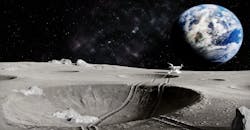As we celebrate the 50th anniversary of the Apollo 11 moon landing, the intrepid astronauts who made the journey and the unflappable scientists and engineers on the ground who helped them get there, our minds naturally go to what that moment represented for humankind, and perhaps, what's next? When will we go back to the Moon, and then to Mars?
That will also take brave astronauts, brilliant engineers and a whole lotta money, as well as hundreds to thousands of industrial players, each with a specific task. We caught up with one of those companies, R.A. Industries, started in 1976 and a supplier of specialized parts to Lockheed Martin and other larger manufacturers, to talk about their aerospace work, which often involves working with exotics metals such as Inconel and beryllium copper. The following were answered via email by Walt Leach, general manager of the Santa Ana-based company.
IndustryWeek: How has R.A. Industries been involved in space exploration recently?
Walt Leach: R.A. Industries is a special part of the supply chain for supporting space exploration and missions beyond the Moon today. We contributed parts to the Mars Rover and to the International Space Station by producing a part made from an entire piece of titanium, the housing for the Fluid Slip Joint project for Japan’s Kibo module, which was used in the water purification system.
IW: How has space exploration affected manufacturing?
WL: The landing on the Moon was an important historical event the United States and the world, but also for the manufacturing industry because it set an expectation and hope for new advancements. Success of a spacecraft piercing and breaking through the earth’s atmosphere depends on multiple factors. In the manufacturing industry of components for spacecraft, expectations are high. This results in only producing the most accurate, indestructible, and functional parts with precision for the space industry.
What are your thoughts on the current efforts to explore Mars?
From what we know of Mars’ conditions, the effort ought to be to boost unmanned spacecraft for exploration. For the last 15 years, NASA’s Mars Rover pioneered this. I trust NASA came away with much information which is useful for the future. NASA reported in the summer of 2020, it will plan to launch the Mars 2020 rover, which will rove around a specific crater area and cache samples and return to Earth.
Without the U.S. efforts for pushing the envelope and exploring unchartered territory, new information cannot be learned and implemented for the future spirit of humankind. Currently, we need to learn more about the planet’s sustainability and benefits—or not—in relations to terraforming Mars.
Unmanned spacecraft seems to the preference. There’s much to be learned about magnetic fields, cold temperatures, rocky terrain and other complicated conditions. Our company will continue supporting missions and space exploration by manufacturing parts with exotic materials for future rovers and spacecraft.
If your industrial company has a space-based story to tell, email [email protected] or tweet @IndustryWeek.
About the Author
IW Staff
Find contact information for the IndustryWeek staff: Contact IndustryWeek

